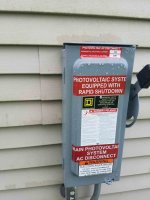Jonathan Bruce
Member
- Location
- Kentucky
- Occupation
- Solar company owner
I have a system we installed which, to the best of my knowledge, is fully code-compliant. The inspector in this case seems to be misled on a number of things, some of which he has dropped during our discussion. The problem at hand is as follows:
The PV modules are each individually connected to a microinverter, and the microinverters are each connected in parallel. We have <16 amps of current in each string of microinverters (2 strings total), and each string is connected via #10AWG THHN to a 20A breaker in a load-center. Power is then fed out of the load-center into a 60A non-fusible 2-pole NEMA-3R AC Siemens Disconnect, and from there go into a 40A breaker in the MSP.
The inspector is quoting (2017) NEC 690.13(f)2 in stating that I cannot use a disconnect which is marked "line" and "load", since they are not suitable for backfeed or reverse current. However, as far as I have been able to find, all UL-listed AC disconnects are marked "line" and "load". None of my suppliers have any such disconnect in their systems. Furthermore, and more importantly, I maintain that having an AC disconnect for this purpose NOT marked "line" and "load" is inherently very dangerous; any technician coming to service the system in the future will not have the source of power clearly marked, and could be led to believe that when the disconnect is turned off, that there is no longer power being supplied or could be led to believe that power is coming from the solar side, which it cannot as rapid shut-down functionality is built into the microinverters (as is required).
For breakers, this code reference makes sense as they are electronic in nature rather than purely mechanical; however, for a mechanical AC disconnect it seems very unreasonable to state that they are not suitable for "reverse" current, since with AC the current flows both ways, 60 times per second, and there are no diodes or sensors which could be in any way damaged by a current from the "wrong" side.
I would appreciate any information or references which could help to clarify this. It's been an ongoing problem/discussion for months.
The PV modules are each individually connected to a microinverter, and the microinverters are each connected in parallel. We have <16 amps of current in each string of microinverters (2 strings total), and each string is connected via #10AWG THHN to a 20A breaker in a load-center. Power is then fed out of the load-center into a 60A non-fusible 2-pole NEMA-3R AC Siemens Disconnect, and from there go into a 40A breaker in the MSP.
The inspector is quoting (2017) NEC 690.13(f)2 in stating that I cannot use a disconnect which is marked "line" and "load", since they are not suitable for backfeed or reverse current. However, as far as I have been able to find, all UL-listed AC disconnects are marked "line" and "load". None of my suppliers have any such disconnect in their systems. Furthermore, and more importantly, I maintain that having an AC disconnect for this purpose NOT marked "line" and "load" is inherently very dangerous; any technician coming to service the system in the future will not have the source of power clearly marked, and could be led to believe that when the disconnect is turned off, that there is no longer power being supplied or could be led to believe that power is coming from the solar side, which it cannot as rapid shut-down functionality is built into the microinverters (as is required).
For breakers, this code reference makes sense as they are electronic in nature rather than purely mechanical; however, for a mechanical AC disconnect it seems very unreasonable to state that they are not suitable for "reverse" current, since with AC the current flows both ways, 60 times per second, and there are no diodes or sensors which could be in any way damaged by a current from the "wrong" side.
I would appreciate any information or references which could help to clarify this. It's been an ongoing problem/discussion for months.


